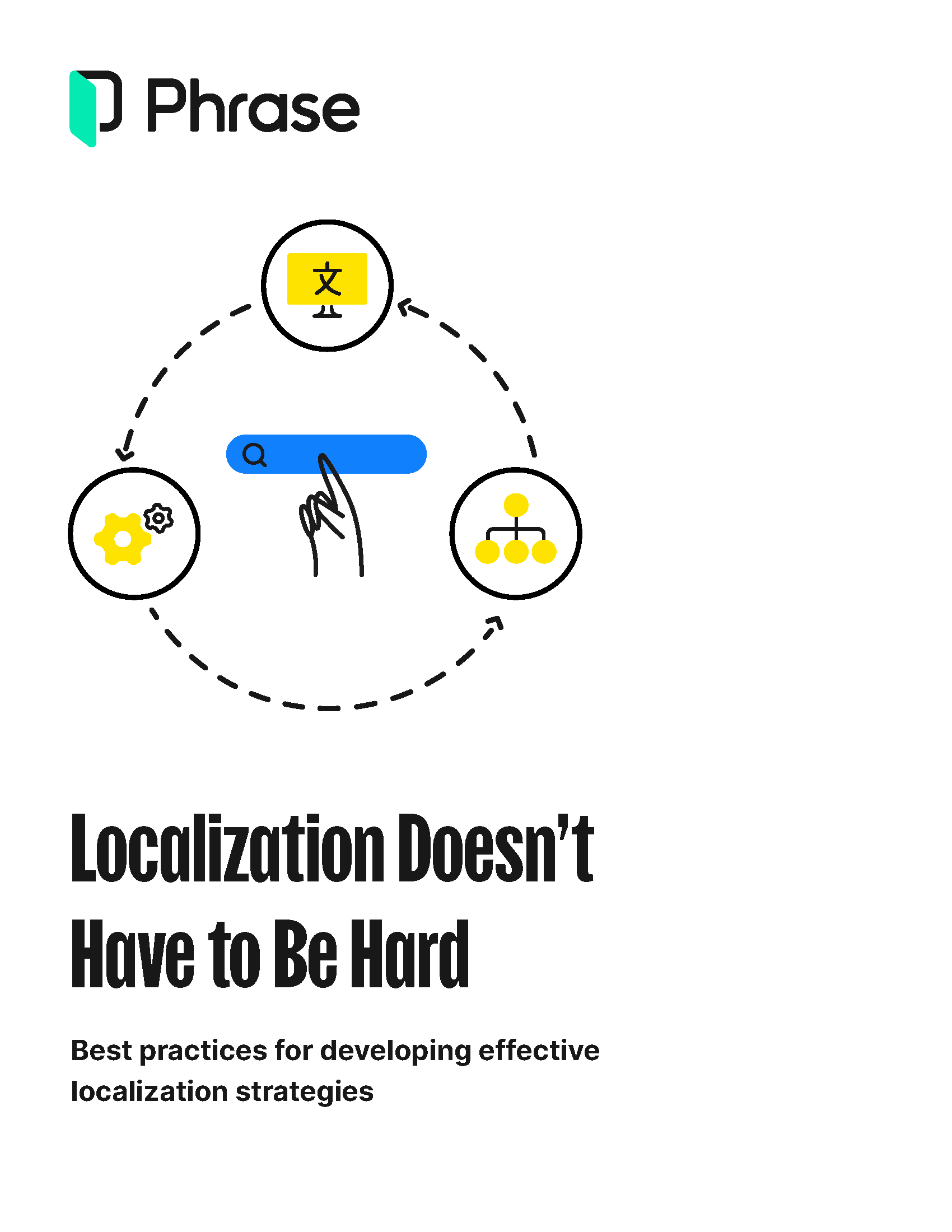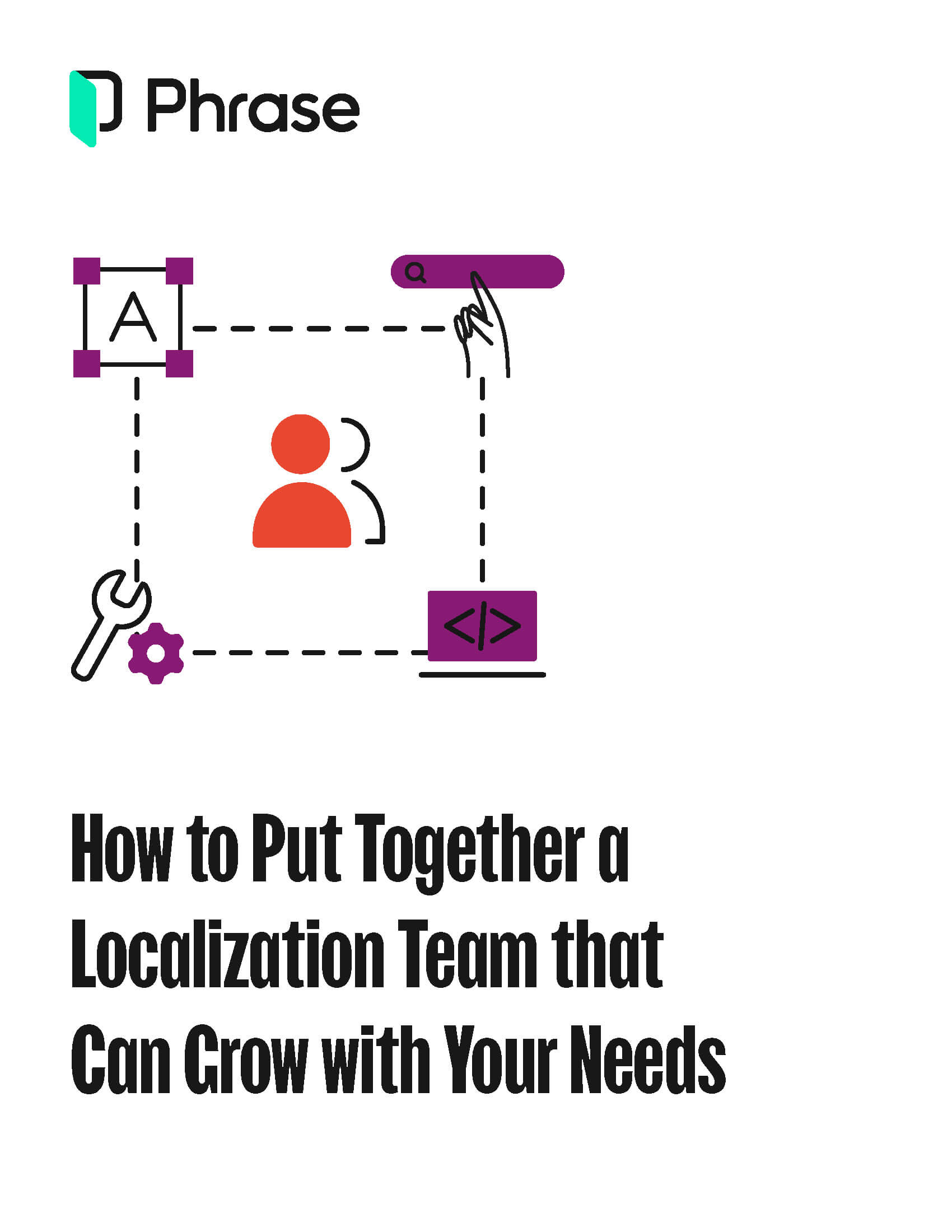Localization strategy
5 Tips for Scaling Localization Efficiently

Personalization. Customization. Individualization. Whenever we hear buzzwords like these, we know that the world of business is changing. Gone are the days of one-size-fits-all products, so more and more companies are putting localization at the top of their growth agendas.
In response to this changing landscape, localization managers are expected to scale the localization effort of their company but still often come short of doing this efficiently. At the same time, many struggle for resources, recognition, and inclusion in the business strategy.
To get a hands-on grasp on the challenge, we’ve profiled the successes of some of the most innovative companies worldwide, learned from their mistakes, and compiled their best practices for scaling localization efficiently. Keep reading to find out how you can do it, too.
Establish a clear purpose for localization
Purpose-driven efforts have the power to galvanize teams and focus their work. When it comes to localization, this means devising a clear language strategy.
A language strategy can be defined as the choice of languages into which a product or service will be localized based on an analysis of a company’s strategic goals and desired customer base. Because each company has different needs and goals, there is no one-size-fits-all language strategy. However, every language strategy needs to align with overall business goals and objectives.
The way to create this alignment is by tying the localization effort to specific key performance indicators (KPIs) such as customer acquisition, customer engagement, revenue growth, support incidents, or anything that is relevant to the company. Moreover, language strategies are confined by factors such as budget, resources, and time, which must also be considered when developing the strategy.
Although language strategies differ greatly between organizations, most consider the same set of factors:
- Business type
- Desired user experience
- Supporting languages
- Resourcing limitations

Free download
Best practices for developing effective localization strategies
Explore how to tackle localization management efficiently and engage customers across the globe in their native languages and local experiences.
Business type
Business-to-business (B2B), business-to-customer (B2C), direct-to-consumer (D2C), and business-to-business-to-customer (B2B2C) companies all operate differently. As a result, their approach to localization will also be different, based on variables such as organizational structures, go-to-market strategies, objectives, challenges, and resources.
For example, a D2C company selling directly to its customers via its website will require website localization, marketing campaigns, product packaging, and so on. However, a B2B2C company that sells exclusively through distributors may require just localized marketing and sales collateral.
Desired user experience
Along with business type, the desired user experience also drives localization decisions. However, what constitutes a good user experience can vary greatly between projects, products, and organizations.
To define your desired user experience, you can ask yourself:
- Why do we want to localize? What do we hope to achieve by doing so?
- What is the ultimate goal—is it to increase sales in a specific market? To improve customer satisfaction ratings? To decrease our website’s bounce rates by making it more relevant to a certain target audience?
- Who are our target customers, and what do they expect from us?
Once you have a good understanding of what the ideal user experience looks like, you can start to align your localization efforts accordingly.
Supported languages
The number of languages supported by a company is also a major consideration in its language strategy—if not the biggest one.
Generally, the more languages a company supports, the more complex its localization process will be. This is because translations need to be maintained and updated as products and services evolve, which can be a challenge for even the most well-resourced organizations.
So some questions worth asking are:
- What languages do we need to support to reach our desired customer base?
- Will we treat all languages identically, or do certain languages deserve more attention and resources? Why so?
- What does our current technology allow us to support? Do we need to invest in new technology that will enable us to expand our language support?
Your answers will be hugely dependent on your circumstances, objectives, and future plans. That’s why it’s crucial to get granular, adopt a tiered support structure, and constantly re-evaluate your language portfolio.
Resourcing limitations
Constraints on resources, such as time, money, and human power, are often the main inhibitors to expanding a company’s localization efforts.
It’s important to be realistic about what can be achieved and set realistic goals. Practically, this means the level of support you afford languages, projects, and initiatives might not be equal. You may invest in human translation for your most important languages, machine translation and post-editing for mid-tier languages, and raw machine translation for low-importance languages.
Once you have your language strategy in hand, you’ll need a team to execute it. This brings us to the second pillar: people.
Build a centralized localization team
Granted: Small businesses can get away with siloed localization efforts if they are only targeting one country or region. But as soon as you expand beyond your home turf, you’ll need to start thinking about how to scale your localization.
A centralized localization team is enterprise-level companies’ best weapon for conquering global markets. This team should be responsible for all localization efforts and activities, from translation and review to QA and publishing.
An effective localization team typically follows one of three archetypes.
In-house (subsidiary) teams
Under this approach, the localization team sits as a division inside the company, typically within the marketing, content, or product departments. The advantage of this setup is that team members are intimately familiar with the company’s products, processes, and culture, and they can quickly adapt to changes. They also typically have direct access to company resources, such as data and employees.
The disadvantage is that this setup can be costly, both in terms of salaries and overhead costs, and it can be difficult to scale if the company undergoes rapid growth.
In-house (standalone) teams
Standalone teams are similar to subsidiary teams except they are their own self-contained business unit. In other words, they are not attached to any specific department within the company.
This has its pros and cons: On the one hand, it can be difficult for these teams to get buy-in from other departments; On the other hand, they have more autonomy and can often be more nimble than subsidiary teams. With a strong enough leader, these teams typically have a higher ceiling than subsidiaries.
Outsourced teams
Outsourcing your localization to specialist consultants can be a very practical way to get started with localization or to supplement your in-house team. It also has the advantage of bringing in fresh eyes and new ideas.
It’s a particularly useful approach when an organization lacks the internal expertise, resources, or bandwidth to build the localization team from scratch—especially in the face of a tight deadline.
However, there are some risks to outsourcing, such as loss of control and quality issues. It’s important to do your due diligence when selecting a partner and to put in place rigorous processes and checks to mitigate these risks.
The functions of a centralized localization team
While the structure of localization teams can vary, the core functions within a localization team should remain stable:
- Top-level management: Effective localization teams have someone at the helm—a program director, localization manager, product manager, or similar. Their job is to turn the company’s strategic goals into team-specific objectives and drive progress toward them.
- Resource management: When operating at scale, there are a lot of moving parts—tools, language service providers, data, and the list goes on. Most teams have a resource manager, vendor manager, or technology manager who is responsible for keeping everything running smoothly.
- Quality management: Enterprise localization efforts can process millions of pages of content per year. With such a high output, a robust testing and quality assurance process is essential. That’s where your quality manager or localization tester comes in.
- Production: While smaller organizations (startups, SMBs, and so on) may work directly with translators, enterprise-level companies will engage language service providers. We’ll explore how to select and work with a language service provider in the next section.

Free download
How to choose the right people for your localization team
Discover the secrets to putting together the right team members to take your localization program to new heights.
Select the right language service provider
If your company is looking to outsource some or all of its localization work, selecting the right language service provider (LSP) is essential—but not always easy.
There’s a lot of variety in the LSP market. Some providers focus on translation only, while others offer a more comprehensive suite of services that may include translation, localization, transcreation, proofreading, training, evaluation, and more.
Further complicating matters, LSPs often specialize in certain industries or markets. A provider that’s great for automotive content might not be the best option for medical device documentation.
When you’re searching for localization partners, we recommend you follow the below three steps to find the best potential partners.
Design a vendor vetting process
Before you even start contacting LSPs, you need to have a clear idea of what you’re looking for. What services do you need? What languages do you want to target? How will you perform quality assurance checks?
Once you have answers to these questions, create a vendor vetting process that will help you shortlist potential partners. Ask about their workflow, including quality assurance and hiring practices. For example, do they ask translators to take a test? Do they have a dedicated quality assurance team in place?
Recruit enough LSPs to create redundancy
With production outsourced, you lose some control over resourcing. After all, you’re relying on the LSP to provide you with the right number of qualified translators in the correct language pair at the right time.
To mitigate this risk, it’s important to work with more than one provider. This will help ensure you always have a backup plan if one of your providers falls short. Building redundancy across languages and services can save you a lot of trouble in the long run.
Perform ongoing linguistic quality assurance (LQA)
While an initial vetting process can help you find a good partner, it’s important to regularly check up on their work. One way to do this is through linguistic quality assurance (LQA), which is designed to ensure that quality is maintained over time.
Have your team perform regular linguistic quality assurance checks on the output of the vendor’s work. If work falls below your minimum threshold for quality, raise the issue with your vendor and work together to identify the root cause.
Refine your localization process
Even with the right strategy, resources, and people in place, localization efforts can still fall short without a well-defined process. A process defines how work is done, who does it, and when it’s done.
When building an enterprise-level localization function, manual workflows, inefficiencies, duplicated efforts, and bloated project management will kill your productivity.
While localization processes will vary between organizations, most high-performance workflows boil down to six core steps:
Preparing assets for localization
The first step is to make all assets available and suitable for localization. There are two major sub-stages:
- Internationalization—making a product ready for localization
- Organization—structuring assets in a way that allows simple localization management
Localization environment creation
The localization manager creates the localization environment. Usually, this means setting up a localization tool, creating different projects, onboarding stakeholders to each, and importing all supporting documentation.
This step provides an opportunity for level-setting and questions. If stakeholders, LSPs, or internal employees have procedural questions, now is the time for them to ask and the localization manager to answer.
Content localization
Once the environment is set up, content localization begins. This involves LSPs and machine translation tools delivering translated content back to the localization manager—through the localization platform or system.
As the content arrives, the localization manager needs to check it and push it onto the next step: revision.
Content revision
This is where you’ll evaluate the work which contains errors in spelling, grammar, and tone, and reviewers flag assets for revisions. The revision stage is usually a lot more efficient when you have a translation management system in place because all stakeholders can collaborate on a single platform—in real time.
Once revised, the localization manager approves the content and marks it as ready for deployment.
Localization deployment
Finalized content is deployed to the target environment—apps, websites, a distribution channel, etc.—and made live.
Whatever the final delivery point, content usually goes through a battery of user interface and code checks to ensure it’s fully compliant with product or document requirements.
Post-deployment QA and monitoring
Measuring localization success is an ongoing task, and it doesn’t end when the product goes live. After each launch, it’s important to monitor your performance, assess your impact, and course-correct.
What metrics are most important will vary from product to product and from business to business. Some typical metrics include site visits, time on page, or user feedback.
Procure the best localization technology
When you’re looking to scale localization, it’s not about translating 1 or 2 pages of content, it’s about translating the equivalent of millions. At this scale, you need to support your endeavors with the best localization technology: a centralized localization technology platform.
Think of it as your localization headquarters, which centralizes all your workflows and translation jobs into a single platform.
With cloud-based localization software, you can track the status and progress of translations. You can also create projects and organize translation tasks, and it can automate work processes like project creation, task assignment, email notifications, and more.

Unlock global business with the Phrase Localization Platform
Expand into new markets with all the tools you need in one technology suite for high-quality, fast, and scalable localization.
Nevertheless, separating the wheat from the chaff in localization technology solutions can quickly become a complex task. So here are 3 key dimensions to consider when choosing the right technology provider for your business:
- Technical requirements: You’ll need to work out exactly what you need from your software. Some common functionality requirements include language options, file type support, automation functionality, and computer-assisted translation (CAT).
- Integrations: TMS solutions typically work in concert with other platforms to power a localization function, either through built-in integrations or through an API. You’ll need to make sure the TMS can integrate with your existing software and systems.
- User experience: No amount of functionality will make up for a bad user experience. Make sure you take into account things like the look and feel of the software, how easy it is to learn and use, and customer support.
Creating a request for proposal (RFP) can help you sift through the multitude of translation and localization technology providers and find one that ticks all your boxes.
Scaling localization doesn’t have to be difficult
When you take a strategic approach to scaling your localization effort, it becomes much more manageable. By focusing on the key elements of purpose, people, partners, process, and technology, you can set yourself up for success in the long run.
This guide outlined best practices for each of those key elements. To get an insight into how world-class localization teams put them into practice, make sure you get a copy of our definitive localization manager playbook.

Free download
The Complete checklist for launching your multilingual website
There’s a lot that goes into a successful multilingual website launch, so make sure you’re on the right track with this proven and easy-to-follow 6-step checklist.





